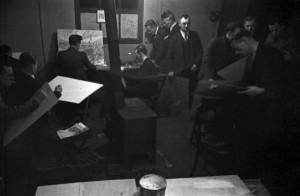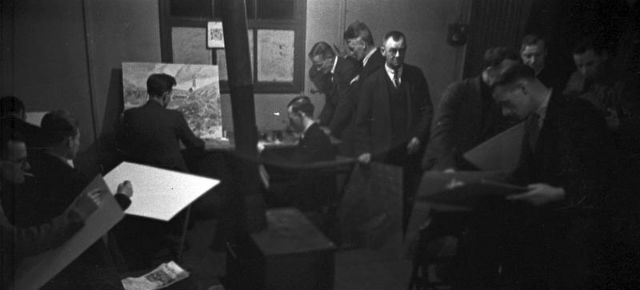
These days, Ashington, a former mining town fifteen minutes’ drive from Newcastle, is best known for giving birth to the Charlton brothers Jack and Bobby, World Cup Winners with England in 1966. But before World War II, this place, lacking public library or art gallery, became famous for something quite different: its painters.
The story of the Ashington Group – miners who became known and remembered painters – began at Ashington WEA (Workers’ Educational Association) night classes under a professional painter, Robert Lyon. The miners themselves would not have known it, but what followed was pure Garreteer:
“Lyon started with lantern slides and lectures on the old masters etc, but found he was getting nowhere. He then abandoned this and had the inspiration of explaining the struggles of an artist to express his feelings by starting us off to paint ourselves. He egged us on to paint what we had to say without bothering about conventions on how to paint. We painted at home and brought the pictures for him to criticise at the next weekly meeting. We became enthralled with this and carried on to paint all we felt about our lives. We adopted ordinary Walpamur paint, bought in bulk, and used boards of plywood or cardboard primed with whiting and size. When we tried oil painting we made our own canvas by stretching butter muslin on boards and priming them. For woodcuts a joiner member prepared holly blocks which we polished ourselves. Our real purpose was not to produce pictures as such (we never dreamed or intended that they should be exhibited) but to get behind the artist and try to appreciate his purpose and methods.” (Oliver Kilbourn)
Learning by doing: at first, posterity didn’t enter into it. “”Many pictures would be thrown away because of lack of space in small homes and mining pictures would not be welcomed by wives to hang on walls: landscapes would be considered more suitable. The women had enough of mining dominating their lives.” (Peggy Parker, who would marry Oliver Kilbourn after the War).
In 1934, Humphrey Spender – later of Mass Observation, who would co-exhibit with the group in 1938 – visited Ashington and photographed the group at work. His pictures show a dark and crowded hut with a coke stove at its centre: well-dressed men prop their latest work on their knees or stand in groups smoking or comparing notes.
The group named itself, and quickly gained the initiative from Lyon, who nevertheless retained an ongoing interest in them and helped secure them exhibition space (pictures were sold to raise funds for further materials) and two BBC appearances, one on nascent television in London, in 1938.
Independence for the group enabled their work to focus more upon their everyday lives, meaning that those pictures by the group that now survive represent a unique historical record, not only of mining life, but of cultural life within mining life.
Interest in the Ashington Group revived in the 1970s and 1980s as the lives of the original members drew to a close, and they were made subject of a serious study by William Feaver and a play at the National Theatre by Lee Hall: Pitman Painters. Although the group themselves took themselves quite seriously enough for none of this to come as a surprise or seem inappropriate, for this onlooker there’s a sense of frustration.
What happened in Ashington – a group of ordinary men cooperating to create art, record their lives and communicate its meaning to outsiders – is still unusual: artistic activity of this kind, supposedly the inheritance of humanity in its entirety. It’s expected from middle class people who have been to university, and there’s a sense of unfinished business: this was supposed to spread, until it was everywhere and genuinely open to all. But the paintings are in a museum; the hut is demolished; there aren’t even any Humphrey Spenders at the moment. There can be: this thread can be picked up and what should have spread then can spread now. But still that sense of frustration.
